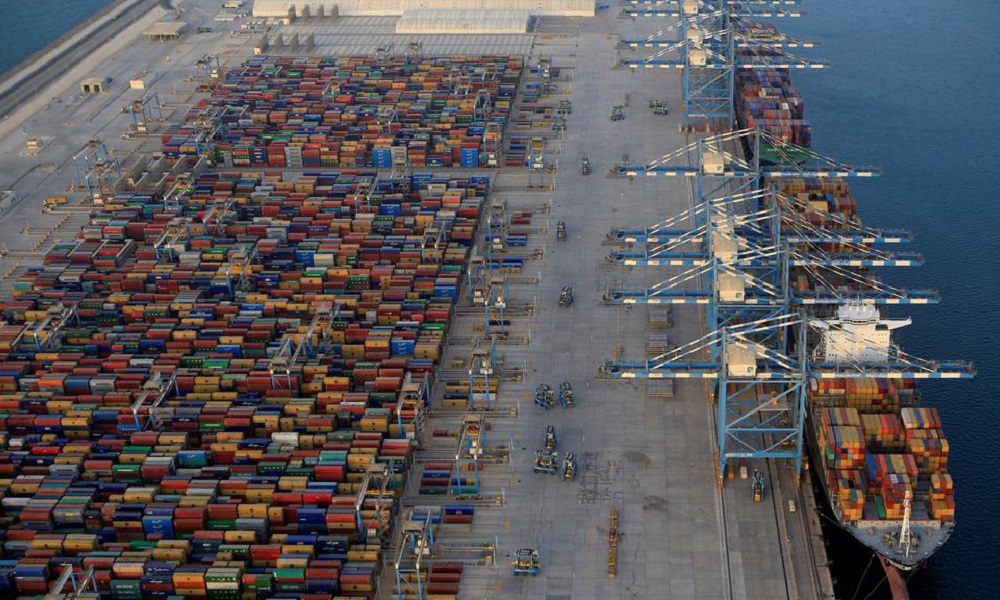AD Ports Group has installed the first 90t block for the quay wall of the new CMA Terminals Khalifa Port – a major milestone in the construction of the terminal.
Announced in September 2021, the development of the new terminal is said to be on track with a budgeted capital expenditure of US $898.4mn. The terminal is expected to be operational in H1 2025 and will be managed by a joint venture owned by CMA Terminals (70% ownership), a subsidiary of global shipping and logistics giant CMA CGM, and AD Ports Group (30% ownership).
AD Ports Group said that it is developing a wide range of supporting marine infrastructure for the terminal, which will provide CMA CGM with a new regional hub. Senior executives from AD Ports Group, CMA CGM, and marine contractor NMDC attended the ceremony, where they signed the block and watched as it was lowered into place via a sea crane.
In July 2022, Abu Dhabi launched a $2.72bn drive to expand its manufacturing sector to over $46bn.

Saif Al Mazrouei, Chief Executive Officer – Ports Cluster, AD Ports Group, said: “Today marks a key moment in the development of the new terminal in Khalifa Port, which will drive increased trade volumes and add new trade links with other high-profile ports, boosting the UAE’s economy. The scale of this 1,200m quay wall is indicative of the ambition of this project, which will create a major hub for CMA CGM, one of the leaders in shipping and logistics, supported by cutting-edge technology and services.”
He added, “With the arrival of CMA CGM, Khalifa Port is now providing hubs for three of the world’s top four shipping lines, consolidating our position as a leading facilitator of trade, logistics and industry.”
Once the quay wall is complete, the signed block will be one of more than 6,000 within the 19m deep berth pocket; the port will be able to accommodate the world’s largest container vessels. Other facilities under development include a 3,500m offshore detached breakwater, a fully built-out rail platform, and 1,000,000sqm terminal yard.
In August 2022, AD Ports launched what was billed as an ‘industry-leading’ logistics hub.

Once ready, the new terminal will have an initial capacity of 1.8m TEUs and will be fully integrated with Etihad Rail. It will significantly enhance Khalifa Port’s connectivity and position as a key gateway for the region, AD Ports Group noted.
Michael Lund Hansen, CEO of CMA Terminals Khalifa Port remarked, “This is an important moment for our company and our partners, as work continues to develop this new terminal, which will expand our group’s shipping and logistics network in the region. Khalifa Port is a leading global hub that supports trade flows in and out of Abu Dhabi. With our new terminal and the shipping line services it will attract, Khalifa Port will see increased connectivity to global markets and further development of multi-modal logistics facilities, and advanced port infrastructure.”
Khalifa Port is said to be one of the world’s most technologically advanced ports, with the first autonomous transport truck system in the Middle East, automated stacking cranes, aerial drones, a 360-sensory system, and an automated Terminal Operation System.
In September 2022, Etihad Rail completed the connection between the ICAD railway freight terminal and UAE National Rail Network.
David Gatward, Chief Engineering and Technical Services Officer, AD Ports Group concluded, “We have made strong progress in the development of CMA Terminals Khalifa Port, as demonstrated by today’s ceremony. In addition to initiating construction of the quay wall, other ongoing marine works including the reclamation of land for the new terminal, construction of a new port basin and an offshore detached breakwater are on track. Recently, the contract for the design and construction of a 33kV substation was awarded as well. The ongoing development and expansion at the terminal will increase our container handling capacity and boost operational efficiency.”

